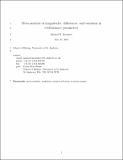Files in this item
Meta-analysis of magnitudes, differences and variation in evolutionary parameters
Item metadata
| dc.contributor.author | Morrissey, Michael Blair | |
| dc.date.accessioned | 2017-10-10T23:32:07Z | |
| dc.date.available | 2017-10-10T23:32:07Z | |
| dc.date.issued | 2016-10-10 | |
| dc.identifier | 243626766 | |
| dc.identifier | cd15c791-9257-4a40-b310-7a4c428b0d91 | |
| dc.identifier | 84985907467 | |
| dc.identifier | 000388311200001 | |
| dc.identifier.citation | Morrissey , M B 2016 , ' Meta-analysis of magnitudes, differences and variation in evolutionary parameters ' , Journal of Evolutionary Biology , vol. 29 , no. 10 , pp. 1882-1904 . https://doi.org/10.1111/jeb.12950 | en |
| dc.identifier.issn | 1010-061X | |
| dc.identifier.uri | https://hdl.handle.net/10023/11828 | |
| dc.description | The author is supported by a University Research Fellowship from the Royal Society (London). | en |
| dc.description.abstract | Meta-analysis is increasingly used to synthesise major patterns in the large literatures within ecology and evolution. Meta-analytic methods that do not account for the process of observing data, which we may refer to as ‘informal meta-analyses’, may have undesirable properties. In some cases, informal meta-analyses may produce results that are unbiased, but do not necessarily make the best possible use of available data. In other cases, unbiased statistical noise in individual reports in the literature can potentially be converted into severe systematic biases in informal meta-analyses. I first present a general description of how failure to account for noise in individual inferences should be expected to lead to biases in some kinds of meta-analysis. In particular, informal meta-analyses of quantities that reflect the dispersion of parameters in nature, for example, the mean absolute value of a quantity, are likely to be generally highly misleading. I then re-analyse three previously published informal meta-analyses, where key inferences were of aspects of the dispersion of values in nature, for example, the mean absolute value of selection gradients. Major biological conclusions in each original informal meta-analysis closely match those that could arise as artefacts due to statistical noise. I present alternative mixed model-based analyses that are specifically tailored to each situation, but where all analyses may be implemented with widely available open-source software. In each example meta-re-analysis, major conclusions change substantially. | |
| dc.format.extent | 23 | |
| dc.format.extent | 491883 | |
| dc.language.iso | eng | |
| dc.relation.ispartof | Journal of Evolutionary Biology | en |
| dc.subject | Meta-analysis | en |
| dc.subject | Synthesis | en |
| dc.subject | Natural selection | en |
| dc.subject | Reaction norms | en |
| dc.subject | QA Mathematics | en |
| dc.subject | QH301 Biology | en |
| dc.subject | BDC | en |
| dc.subject | R2C | en |
| dc.subject.lcc | QA | en |
| dc.subject.lcc | QH301 | en |
| dc.title | Meta-analysis of magnitudes, differences and variation in evolutionary parameters | en |
| dc.type | Journal item | en |
| dc.contributor.sponsor | The Royal Society | en |
| dc.contributor.institution | University of St Andrews. School of Biology | en |
| dc.contributor.institution | University of St Andrews. Centre for Biological Diversity | en |
| dc.identifier.doi | 10.1111/jeb.12950 | |
| dc.description.status | Peer reviewed | en |
| dc.date.embargoedUntil | 2017-10-10 | |
| dc.identifier.grantnumber | UF130398 | en |
This item appears in the following Collection(s)
Items in the St Andrews Research Repository are protected by copyright, with all rights reserved, unless otherwise indicated.

